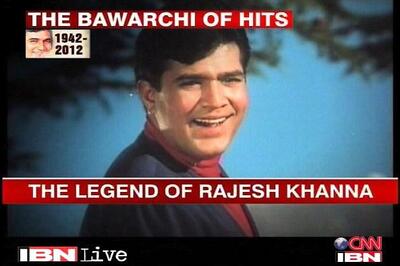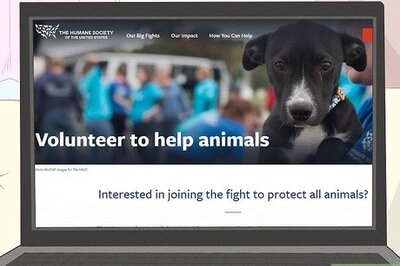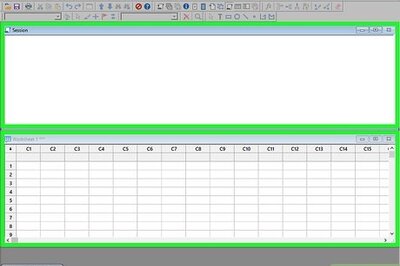
views
Beard Styles without a Mustache
Chinstrap Chinstrap beards, also known as “Amish beards,” wrap around the bottom of your chin and connect with your hair near your ears. Chinstraps accentuate your jawline and make your facial features really stand out. Who it Works For: Chinstraps look their best on oval-shaped faces with strong jawlines. How to Style: Opt for a thinner chinstrap if you have a narrow face or a wider chinstrap if you have a more square face. If you want to make your face look longer, grow your chinstrap out even more.
Goatee A goatee is a simple beard style where you only grow hair on your chin but trim your upper lip and cheeks. Goatees can be shorter or longer depending on what style you prefer to wear. While some goatees also include a mustache, they look just as good without one. Who it Works For: Goatees work well for any face shape. If you have a narrower face, then a small goatee on your lower chin also looks great. How to Style: Woody Lovell, a barber, says a small, sharp razor works best for creating the sharp lines of a goatee. If you want to make your face look longer, then let your goatee grow out more.
Soul patch If you want a lower-maintenance style that still has a little bit of edge, a soul patch just below your lower lip can be the perfect fit. Soul patches look great whether you’re clean-shaven or want to rock a bit of stubble. Who it Works For: Soul patches work well for any face shape, but they look their best if you have a darker hair color. How to Style: Shape the hair under your bottom lip into a small triangle for a clean and classic look.
Landing strip A landing strip is like a soul patch, but it’s wider and runs from your bottom lip down to your chin. Landing strips are low-maintenance and they give your beard a striking look. Who it Works For: Landing strips look the best on long or oval-shaped faces. How to Style: Trim the sides of the landing strip straight so they have a clean edge, and keep your facial hair short
Chin puff A chin puff is when you only leave a patch of your beard growing on the bottom of your chin. Chin puffs give your face a clean and streamlined appearance, so they’re great if you want a minimal style. Who it Works For: Chin puffs work on any face shape, and it looks especially good if you have curly facial hair. How to Style: Leave the hair only on the bottom of your chin and keep the style short so your beard doesn’t look unruly.
Square beard Square beards are similar to goatees, but the top and edges are more angular and squared off. This style is simple to pull off and looks great whether it’s long or short. Who it Works For: Square beards look the best on round faces to help make your jawline more angular. How to Style: Use electric trimmers or a sharp razor to cut the clean edges of a square beard. Line up the outer edges of your beard with the corners of your mouth.
Lincoln beard If you want a beard that’s for for a president, then copy Abraham Lincoln’s famous beard with no mustache. A Lincoln beard is simply a full beard with the mustache shaved off, so it’s a really easy style to maintain. Who it Works For: Lincoln beards typically look best on elongated or angular faces. How to Style: Leave the facial hair on your cheeks and neck a little longer for a more rugged look. Alternatively, trim your beard short for a cleaner presidential style.
Van Dyke A Van Dyke is similar to chin puff, but it has a defined point at the end. Even though many people rock a styled mustache with a Van Dyke, it looks just as good without one. Who it Works For: Van Dykes work well on any face shape, but work well for making round and square faces look longer. How to Style: Keep a Van Dyke long or short, but be sure to trim and straighten the edges whenever they look unruly.
Eagle beard An eagle beard resembles a goatee, but the top is trimmed to look like the head and wings of a bird. This bold style is prefect if you’re looking for something unique that’s sure to stand out. Who it Works For: An eagle beard looks great no matter what face shape you have. How to Style: Keep your beard short to help it maintain its iconic shape.
Anchor beard An anchor beard looks like a goatee with a landing strip and pointed edges going up to the corners of your mouth. While Tony Stark usually pairs an anchor beard with a mustache, you can rock this style without one all the same. Who it Works For: Anchor beards look great if you have a round, square, or elongated face. How to Style: Keep an anchor beard trimmed and well-defined so it doesn’t lose its shape.
Klingon beard If you’re a fan of Star Trek, then the Klingon beard could make a unique statement. Klingon beards look just like full beards without a mustache, but you keep the hair going up to the corners of your mouth. Who it Works For: Klingon beards work best if you can already grow a full beard without patches, and they look good for any face shape. How to Style: Keep a Klingon beard trimmed short because it can start to look messy and unkempt when it grows out.
Mutton chops Mutton chops are an old-fashioned look where you keep your sideburns and hair on your cheeks, but shave your mustache and chin. If you want facial hair that looks more like Wolverine or a classic rocker, then mutton chops are a great choice. Who it Works For: Mutton chops tend to look the best on oval-shaped or round faces. How to Style: Align the ends of your mutton chops with your cheekbones. Keep your facial hair trimmed for a clean appearance, or leave it long for an outdoorsy look.
Chin curtain Chin curtains are the most traditional look for a beard without a mustache, and they cover the entire area under your chin. Chin curtains can connect with your hairline by your ears, or you can leave your beard separate so it stands out more. Who it Works For: Chin curtains look great on oval, heart, and square face shapes because they can make it look like you have a stronger jawline. How to Style: Keep the hair on your cheeks and neck clean-shaven so it looks clean. Trim the hair closer to your head near your ears, and let it grow out longer on the bottom of your chin for a striking look.
Viking beard While standard Viking beards have a mustache, the style also looks great without one! Viking beards are usually shorter on the sides with a longer hair on your chin formed to a point. Who it Works For: Viking beards work well for round faces because they can make your face look longer and your jaw look wider. How to Style: Let your facial hair grow about halfway up your cheeks, and trim the hair on your chin so it forms a point.
How to Grow a Beard and No Mustache
Trim or shave your mustache as you grow your beard out. Juan Sabino, a barber, says to use beard trimmers to “get [your mustache] as short as you can to where it's almost like a five o'clock shadow” so it’s easier to shave. He continues, “use soap to wash your face and make sure you lather it all up…and that will cause the hair to soften up.” Then, just use a razor following the direction of your hair growth to get a clean shave. If you want your skin to look better when you finish shaving, barber Marlon Rivas says to “splash cold water back on your face and that will close up the pores and it will give you an even closer looking shave.” He continues, “it closes the pores back up and the skin constricts itself back to the regular look that it's supposed to have.”
How to Care for a Beard with No Mustache
Shave your mustache at least once a week. After shaving your mustache for the first time, you’ll probably see stubble grow back over the next day or two. Keep your upper lip looking clean by using a razor or electric trimmer. If your mustache grows back more quickly or if you don’t like the look of stubble, then shave it every 1-2 days. Timmy Yanchun, a barber, explains that you should probably wash and condition your mustache for a closer, cleaner shave.
Wash your beard every few days. Try to use beard wash specifically made for facial hair, but standard shampoo also works in a pinch. Wet your beard and lather the soap in down to the roots. After you work the soap in, rinse out all of the suds. After washing your beard, work a beard conditioner into your facial hair to help soften it. EXPERT TIP Marlon Rivas Marlon Rivas Facial Hair Specialist Marlon Rivas is a Barber and Owner of MGX Professional Men's Grooming, a barbershop based in the San Francisco Bay Area. He is also the founder of Busystyle.com, a service that provides online scheduling services to businesses in the barbering and beauty industry. Marlon has over 15 years of experience in managing and providing barber services. Marlon Rivas Marlon Rivas Facial Hair Specialist Beard shampoo is the top choice for washing your beard. You can use regular shampoo, but they do have shampoos that are really catered to your beard that's designed for the skin around your face. Your hair follicles create more oil on your scalp versus the follicles on your face, so beard shampoos are specially designed to be more sensitive to your skin.
Brush and comb your beard. A beard brush helps exfoliate your skin and spread natural oils over your facial hair while a beard comb helps remove tangles from longer hairs. If your beard is starting to look messy or has stray hairs poking out, run the brush or comb through your beard from top to bottom. Keep brushing or combing until your beard looks clean and neat.
Apply beard oil to moisturize your facial hair. Rivas mentions that beard oil “gives the beard a little bit of a fuller, uniform look and it maintains the straggly hairs” so it’s an important part of your routine. He says, “start with just a drop or two and rub it into your hands. Then apply it and massage it into the beard, and then stop by brushing it with a brush or a comb, and then just let it sit there throughout the day.”
Trim your beard regularly to keep it looking neat. Either use a beard trimmers with a guard or grooming scissors to clean up your beard when it starts to look messy. Trim around your neckline and cheeks to get rid of stray hairs, and cut off any long or unruly hairs that stick out from your beard. When you shave your neck, Rivas says its best to start at the midpoint between your jaw and Adam’s apple. As you get closer to your ear, start to follow the jawline more closely for a neater appearance. Lovell warns, “you do not want to make any unnatural facial expressions when you're trimming facial hair, because if you…you go back to a natural expression, it's in a different place.”
FAQs
Why do some people have a beard and no mustache? Some people shave their mustache because they prefer how their beard looks without one. Other people may shave their mustache because their facial hair is patchy and doesn’t grow in completely. Some people may not have a mustache due to their religion, such as the Amish and some Muslim groups.
Does a beard without a mustache look good? A beard without a mustache can look good if it matches your face shape. Rivas explains, “a person with a more rounded [face] shape should wear their beard a little bit tighter in the area where it grows by the ears. And in the cheekbone areas, trim it down with a slightly more of a blend, so the face doesn't look as round. …And then vice versa for the person with a slimmer face. You might want to have it a little bit fuller in the cheek area so your face fills in a little bit more and gives you more of a fuller look.”
What is a beard without a mustache called? There are multiple ways to grow a beard without a mustache, so what you call it depends on the style. If you only have hair on your chin, it’s usually called a “goatee” or “chin puff.” Longer beard styles that go around the bottom of your head are commonly called “chinstraps” or “chin curtains.” If you’re not sure what a style is called, show a picture to your barber. They’ll be able to tell you what it’s called and if it will look good with your face shape.




















Comments
0 comment